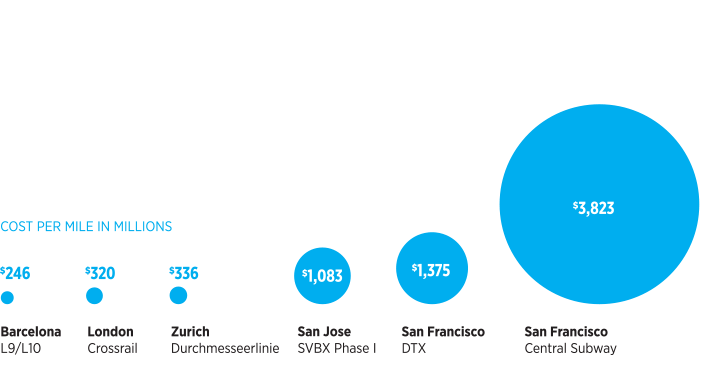In the last decade, the Bay Area’s transit network did not keep pace with its jobs and population: The region failed to maintain its aging transit systems or add new infrastructure to support its unprecedented growth. By 2019, getting around had become slow, inconvenient and painful, and most of the region still remained inaccessible by transit. Today, in the midst of a pandemic, it is even harder to imagine how the region will make significant investments in transit. COVID-19 has drastically reduced ridership and revenue, and it will leave transit agencies with shrunken budgets for years to come.
But cities still need transit, and recovering from the economic downturn, responding to apocalyptic climate impacts, and creating a more fair and equitable region will require planning and building a better transit network. Now more than ever, we can’t afford to gamble with the investments we do make. It’s imperative that we do more with less.
This means taking a close look at the planning and delivery of major transit projects, especially megaprojects costing over $1 billion. Around the world, delivering megaprojects is notoriously difficult. Yet the Bay Area has an especially poor track record: Our projects regularly take decades from start to finish, and our project costs rank among the highest in the world. Many projects have come to cost so much that it’s easy to cast doubt on whether we should be building them at all. Out of more than 90 capital projects submitted to the Metropolitan Transportation Commission in 2019 for funding consideration in Plan Bay Area 2050, fewer than a dozen had benefits that exceeded costs.
International Comparison of Construction Costs for Rail Projects

American urban rail projects regularly cost more on a per-mile basis than comparable projects in Europe. This graph compares the costs per mile (in US dollars) of a sample of urban rail projects with a significant amount of underground tunneling.
To see the Bay Area’s next generation of major transit infrastructure projects built more quickly and cost-effectively, we need to change the governance of project delivery. In our new report More for Less, SPUR recommends rethinking the way the Bay Area delivers transit projects, offering policy proposals that will save time, save money and add up to a reliable, integrated and frequent network that works better for everyone. We group our recommendations into three big ideas:
Big Idea 1: Improve regional transportation planning, project selection and project oversight.
The causes of cost and delay start well before a project breaks ground. The Bay Area has historically selected projects without a rigorous selection process based on a regional vision or objective cost-benefit metrics. Further, there are currently few incentives to control project costs. Bigger roles for the Metropolitan Transportation Commission in project selection, project oversight and risk management will be key.
Big Idea 2: Create a new organization to deliver the region’s most significant and high-risk projects.
A chief reason why the Bay Area has struggled with project delivery is because the region builds so few projects. Every project falls victim to “first timer” mistakes. We recommend establishing a single organization that would deliver all of the region’s most significant projects. Our concept paper Infrastructure Bay Area details a proposal for this new institution.
Big Idea 3: Streamlining environmental laws for projects that deliver significant environmental benefits.
California’s foremost environmental protection law, the California Environmental Quality Act (CEQA), is often used inappropriately to delay or stop transit and sustainable transportation projects that would have significant benefit to the environment. Adapting CEQA for the most environmentally beneficial projects could reduce project costs and timelines, accelerating the transition to a more sustainable, affordable and healthy transportation system.
Delivering better transit is a determining factor in the region’s ability to reduce greenhouse gas emissions. The Bay Area is expected to fail to meet its 2035 climate targets, in part because it has not delivered efficient and reliable transit that makes transit more attractive than driving. All realistic paths toward achieving dramatic reductions in greenhouse gas emissions involve transit capacity and transit connections that simply do not exist today. Reforming the delivery of major transit projects is a problem that cannot wait.
Read the More for Less report
Read our proposal for a new transit delivery organization
